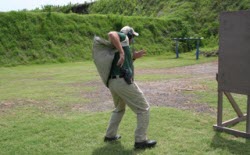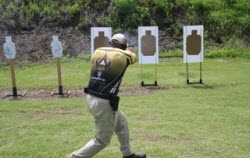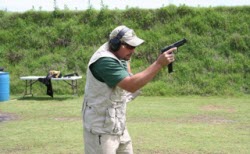I’ve often been asked, “Does practical shooting under the stress of competition offer training benefit to those who want to use these skills for combative purposes?” My answer is a strong yes, and I will break down why in this two-part article. In part 1, I will draw correlations between the two areas (combative and competitive) in each of the five critical skill-sets. In part 2, I will break down each of those skill-sets and discuss training concepts for each area.
Why listen to me? Consider my background. Competitive experience: I am a card-holding GM in USPSA, Master in IDPA, and a Master in the NRA classification system. I have done well in pretty much every major match and have competed against the best shooters on the practical shooting circuit for over 10 years. Combative experience: I am a former Marine with combat experience (if Desert Shield/Storm counts as combat!). I have local and federal law enforcement experience, including more than 10 years as a full-time instructor or lead instructor. A portion of that time I was in charge of the Federal Air Marshal (FAM) firearm-training program during the FAM buildup after 9/11.
I have had the privilege of working with some of the best military and law enforcement instructors in the United States, and I credit all that I submit to you in this article to folks I have worked with and learned from. What should this mean to you? It means I have done my homework in both arenas and can hopefully offer some insight into how practical shooting translates to quality training for combative purposes.
Wow! Get some practice time first? What happens if the stuff goes down tonight? Will you tell the bad guy to wait until after you practice to start the fight? I think not. I had no doubt about my skills and ability to perform under stress and on demand. Why? Because I had spent hundreds of hours training myself to get the gun out of the holster and rounds downrange, and had validated these skills under stress during my agency training as well as at practical shooting matches. So the real question is, what happens when we compare the skills needed to excel in practical competitions to real world fighting skills with a firearm?
First, let’s set the record straight. I advocate using practical competitions and the training that goes with them in addition to regular law enforcement, military, or civilian self-defense training programs. Winning a gunfight is a combination of solid tactics, good manipulation skills, and an aggressive will to win the fight. Competing in a match will not train you; it will, however, validate your marksmanship and manipulation skills under stress.
The left column of the following table contains five skill areas that are critical to perform well during practical shooting matches. The middle column describes how each skill is applied in competition. The right column compares that same skill and outlines its application in a combative environment. In Part 2 of this article, I will describe exactly how we train each skill.




I agree with everything you say in regards to movement, gun handling and marksmanship transferring from matches and testing ability under stress. However, from what I've seen in matches the use of tactics is highly flawed, use of cover nearly non-existent, blading targets from cover etc. nearly non-existent. Doing so adds too much time. I keep reading that we fight as we train and practice. If we go through matches as most do I don't see those people fighting in any other way. This aspect of match participation by serious defensive minded people bothers me.
Great article Mike. I can't seem to find the table you mention in part 1 of your article
There's no table
Want to learn for self defense
Anything that can raise your strees level in training will help if you are found in a defensive situation.
Hi Mike, Thanks for taking the time to write this. Where is the table referenced in the article (specifically again in the concluding paragraph)? It's not in the 2nd part either.... Thanks!
Excellent, Mike!! I look forward to your contributions here. Bill